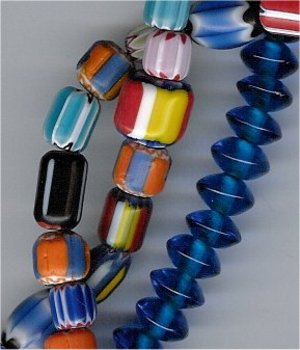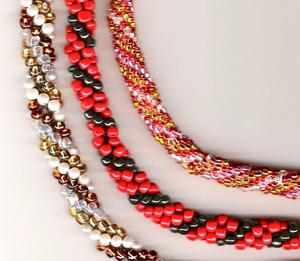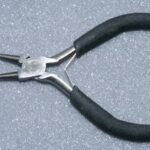Centuries ago, Native Americans made their own beads by hand. The most beautiful type of beads were called ‘wampum’ and were used as money. Wampum is a Narragansett word that means ‘white shell beads,’ but traditionally they came in two colors: purplish-black and white. The white beads were made from the Whelk shell and the dark ones from the Quahog shell. Only after Native Americans made contact with Europeans did they begin making entire belts from wampum beads.
To make wampum beads, the Native Americans would first bust a large shell into pieces with a rock. Then a thick, bead-sized piece of clam shell would be selected (usually about one inch long and a half inch wide). Using this piece as raw material, the craftsman would then drill a hole through it – with drilling always being the first step so they wouldn’t have to do all the painstaking work of rounding and polishing the shell only to have it crack later when they drilled the hole for the string. Also, the bead is much easier to hold for drilling when it’s in a rougher state than when it has already been rounded off.
To drill the hole, they would make a crude vise for holding the shell by splitting the end of a willow branch. The piece of clam shell was then placed in the split part and a thong or cord tied around the branch on each side to securely clamp it. Then they drilled the hole using a primitive hand drill which contained a bit made from a sliver of flint.
After the hole was made, the bead would then be rounded and polished by rubbing it on stones of coarse grit at first, then progressively finer and finer grit would be used.
The result of this tedious process was a precious object as beautiful as a silver or gold coin.
If you don’t have any shells, you can also make beads out of wood, although they won’t be wampum beads. The easiest way to make wooden beads is to select a tree limb that has a pith in its center, such as ash wood. Select a section of limb that is about the diameter of the beads you want. Before you start though, make sure the wood is not green. If you make beads from green or unseasoned wood they will dry out and crack and your work will be wasted. The wood should be seasoned for at least three months.
After selecting a seasoned section of tree limb with a pith the proper diameter, simply twist a piece of thin wire through the pith to remove it. After that, mark the limb around its circumference. Make the marks a little farther apart than the diameter of the limb. Then file around the marks with a three-cornered file. Make the marks deep but be careful not to break or separate the beads from the section. If the wood is too hard or your file isn’t coarse enough, you can use a hacksaw blade to deepen the marks.
Now being careful not to break the beads from the section, use a pocket knife or small knife to whittle the edges of the beads and round them off. Then sand up and down the section with fine and finer sandpaper to smooth and polish the beads. But don’t use a sanding block. Just hold the sand paper and let it flow and follow the contours of the section beneath your fingers. Finally, use a saw to cut the beads apart, then sand and polish the sawn ends.
If you can’t find limbs with piths, the centers can be drilled out. Hold the limb in a vise, or clamp it when drilling for safety reasons. Don’t ever hold the limb in your hand while drilling. If the hole goes off center, simply use the part of the limb that has a centered or nearly centered hole and discard the rest.
Fragrant beads can also be made by using cherry or peach wood. When rubbed, they will emit a pleasant aroma.
Beautiful beads can also be made out of bone. Large bones from the meat market can be used. But the bone must be seasoned as with wood, and the meat and grease has to be entirely cleaned off. An unconventional yet effective method for cleaning bones is to saw them into sections and place them on top of an ant pile to lay in the hot sun for a few weeks.
If you decide to make beads out of bone, be sure to wear a dust mask and eye protection when working with them. Bone has a grain like wood but it is much harder like ivory and will produce a fine dust when sanded. Bone will be the hardest substance to work with when making beads.
One final fact about wampum: The fur trader Jacob Eelkes was the first person to discover just how valuable wampum beads and belts were. In 1622 he captured a Native American chief and said he would decapitate him unless he was given a large sum of money. The leader gave Eelkes a 840-feet long wampum belt and told him he could trade it to Indians for many more pelts than his other European goods would bring. After that incident, wampum became a form of currency at trading posts.





